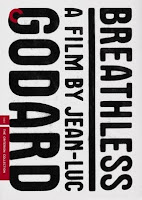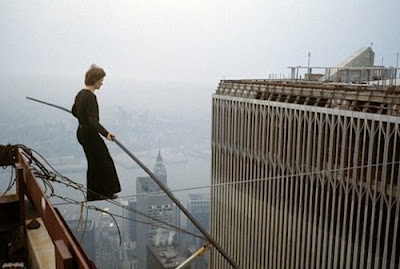 BREATHLESS may not have been the movie to "officially" kick off the French New Wave, but after its release there was little doubt it would be the standard bearer for the movement. Written and directed by Jean-Luc Godard based off a treatment by Francois Truffaut, BREATHLESS leaps off the screen and tears into its story with a youthful exuberance that embraces its roots in American genre films while gleefully tearing apart the staid tenets of how those films are structured.
BREATHLESS may not have been the movie to "officially" kick off the French New Wave, but after its release there was little doubt it would be the standard bearer for the movement. Written and directed by Jean-Luc Godard based off a treatment by Francois Truffaut, BREATHLESS leaps off the screen and tears into its story with a youthful exuberance that embraces its roots in American genre films while gleefully tearing apart the staid tenets of how those films are structured.
This was my introduction to Godard, and watching it for the first time I was amazed at how fresh and exciting it feels almost 50 years after its initial release. Roger Ebert hails it as the beginning of the modern movie, and the most influential debut since Orson Welles and CITIZEN KANE, and it's hard not to think the same. The story centers on Michel, a small time gangster who idolizes Humphrey Bogart and the materialistic freedoms of America - the cars, the movies, and the women. BREATHLESS opens with Michel nonchalantly stealing a car, and as he tears through the countryside Godard demonstrates what makes this a "modern" movie - Michel's mouth motors as quick as his car, and as he goes from topic to topic Godard's "jump cutting" technique is introduced - the editing almost seems to stutter, catching the dialog just after it begin only to clip just before it ends. The technique forces the viewer to become a participant in the conversation, desperately trying to keep up with what Michel is saying - a hopeless cause. For a brief moment he even turns to the camera, breaking the fourth wall and even more directly drawing the viewer into his world before he's off again, daring us to catch up. Soon he's stopped by the police and, having found a gun in the glove compartment, suddenly kills the patrolman in what looks to be a quick, gut reaction to getting caught. This sets up the rest of the story as Michel attempts to collect enough money to leave the country with Patricia, an American girl he fancies after a brief fling some time before.

But while the actual plot points of BREATHLESS are ripped directly from the Western gangster films of the 40s and 50s, the execution of the plot is anything but a retread. The editing is wonder at both ends of the spectrum - the jump cutting is continuously used to great effect, acting as a visual companion to the pace and tone of Michel's comments and eyeline. During a cab ride he tells Patricia how beautiful she is; the editing not only clips the dialog into brief, aural impressions but visually accents her face, her neck, wherever his eyes roam.
But what also stands out are the long, uninterrupted takes that echo the languid, bored moods of Michel and Patricia, especially in one particular scene up in her apartment. Michel spends the majority of the time trying to convince Patricia to sleep with him, but the movement and pacing betrays his boredom by not cutting away and focusing on his slow body movements and the endless little bits of distractions between them. The lighting is mostly natural, sunlight filtering through cigarette smoke in a haze that further enhances the feeling of emptiness insider the characters.

BREATHLESS also plays with unconventional methods of communicating the story. Michel walks down a street and the camera lingers on a passing sign that reads, "Live Dangerously Until the End!" Rather than show the police closing in on Michel, Godard uses newspapers and scrolling marquee signs flashing bulletins as Michel coincidentally drives by to signal their progress. And in perhaps the most ironic moment of the movie, a passerby who recognizes Michel and points him out to police is none other than Godard himself, thus directing the course of the film simultaneously in front of and behind the camera.
Would this movie have worked with different actors? It's hard to say, because what Jean-Paul Belmondo brings to Michel is an oddball electricity that would be hard to replace. Big, pouty lips and a broad nose, up close he looks far from the typical matinee idol, but his lithe movements and boundless charm make it easy to understand why he was a top drawer in France for so many years. His Michel is all sheen and bravado up front with a frightened kid just below the skin, and nowhere after the first five minutes of the film is it believed he's as tough as he claims to be. Even his tough guy actions - the initial murder, the muggings and bullying threats, betray a scared indecision, a life purposely without direction.
And the first moment Jean Seberg appears on-screen, walking up and down the street selling newspapers with her New York Herald t-shirt, it's impossible to look away. She's gorgeous and enigmatic and in her own way just as empty inside as Michel. There's a weird detachment to her actions and words that speaks to a coldness Michel never recognizes until it's too late. She announces she's pregnant, but the way she says it feels clinical, as if looking for a reaction from Michel. Is it true? She speaks to a friend and potential lover earlier where her condition is perhaps obliquely referenced, but that may have been a lie as well. Later, she coldly manipulates Michel's capture because, her thinking goes, if she can do something bad to him, it proves that she doesn't really love him. This sets up the wonderfully iconic ending, and one of the best last lines in movies, as Michel meets his end and maybe gets a glimpse of reality before the movie ends.
All together, BREATHLESS works to create a fresh and clear starting line for many of the things taken for granted on modern films. It celebrates American cinema even as it makes a case for the new wave of French cinema. The plot, characters, and style all coalesce into something where, for once, the reputation is less than adequate.

 "Why? Why is he doing it?"
"Why? Why is he doing it?"












